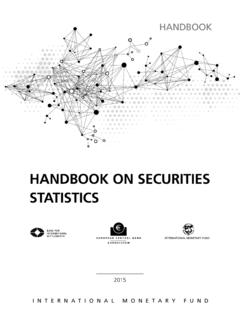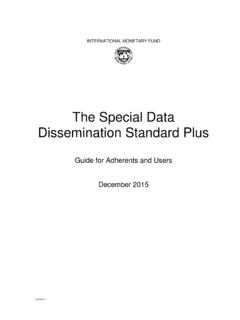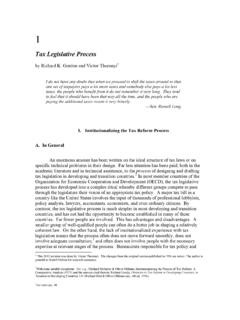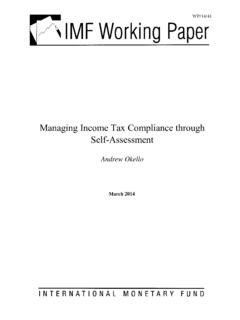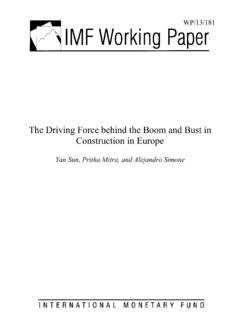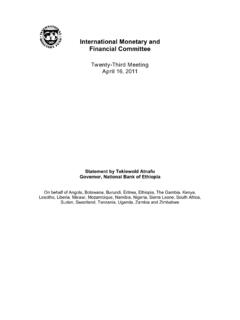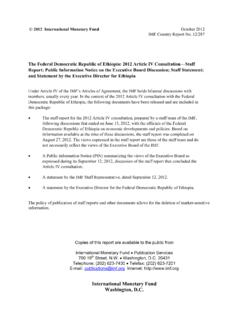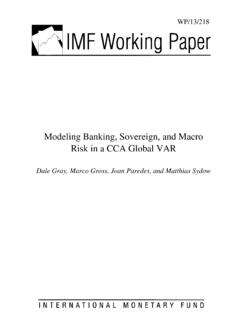Transcription of Classifications of Countries Based on Their Level of ...
1 Classifications of Countries Based on Their Level of Development: How it is Done and How it Could be Done Lynge Nielsen WP/11/31 2011 International Monetary Fund WP/11/31 IMF Working Paper Strategy, Policy, and Review Department Classifications of Countries Based on Their Level of Development: How it is Done and How it Could be Done Prepared by Lynge Nielsen1 Authorized for distribution by Catherine Pattillo February 2011 Abstract The paper analyzes how the UNDP, the World Bank, and the IMF classify Countries Based on Their Level of development. These systems are found lacking in clarity with regard to Their underlying rationale. The paper argues that a country classification system Based on a transparent, data-driven methodology is preferable to one Based on judgment or ad hoc rules. Such an alternative methodology is developed and used to construct classification systems using a variety of proxies for development attainment.
2 JEL classification Numbers: O10, O15, O19 Keywords: Country classification systems, developing Countries , developed Countries Author s E-Mail 1 Special thanks are due to Russell Kincaid who provided extensive commentary on earlier drafts. I would also like to thank Pedro Conceicao, Sarwat Jahan, Namsuk Kim, Heloisa Marone, Samar Maziad, Prachi Mishra, Catherine Pattillo, Barry Potter, Martin Ravallion, Luca Ricci, Francisco Rodriguez, Mick Silver, Eric Swanson, and Yanchun Zhang for useful comments and inputs. The usual disclaimer applies. This Working Paper should not be reported as representing the views of the IMF. The views expressed in this Working Paper are those of the author(s) and do not necessarily represent those of the IMF or IMF policy. Working Papers describe research in progress by the author(s) and are published to elicit comments and to further debate.
3 2 Contents Page I. Introduction ..3 II. Development, Development Taxonomies, and Development Thresholds ..5 III. International Organizations Country classification Systems ..7 A. United Nations Development Programme s Country classification System ..8 B. The World Bank s Country classification Systems ..9 C. The IMF s Country classification Systems ..14 D. Comparison of Approaches ..18 IV. An Alternative Development Taxonomy Methodology ..19 V. Examples of Alternative Development Taxonomies ..32 VI. Concluding Remarks ..41 Tables 1. The World Bank's Operational Income Thresholds ..12 2. The World Bank's Analytical Income Thresholds ..14 3. Country classification Systems in Selected International Organizations.
4 19 4. Country Classifications in Selected International Organizations ..20 5. Trichotomous Development Taxonomies (Population Weighted) ..33 6. Trichotomous Development Taxonomies (Equally Weighted) ..37 Figures 1. Dichotomous Development Taxonomy ..27 2. Trichotomous Development Taxonomy ..28 3. Development Taxonomies ..31 References ..42 Appendix ..44 3 There are two kinds of people in the world: those who divide the world into two kinds of people, and those who don't. - Robert Benchley I. INTRODUCTION The Kuhnian view of (normal) scientific progress is the result of productive discourse among people who share a common understanding of the basic building blocks of Their chosen field of study.
5 In most fields an important part of this shared common understanding the broadly agreed paradigm is Classifications . While the importance of Classifications varies from field to field, Their ubiquity is testimony to Their usefulness. For example, the IMF defines balance of payments transactions as occuring between residents and non-residents of Countries , where a resident is defined as an economic unit with a center of economic interest in the country of one year or longer. A one year length of stay in a country is an objective, if arbitrary, benchmark for resident status as an economic but not legal concept. This simple definition facilitates the construction of internationally comparable balance of payments data because the resident/non-resident definition is broadly accepted among national statistical agencies charged with compiling balance of payments data.
6 In constrast, when it comes to classifying Countries according to Their Level of development, there is no criterion (either grounded in theory or Based on an objective benchmark) that is generally accepted. There are undoubtedly those who would argue that development is not a concept that can provide a basis upon which Countries can be classified. While difficult conceptual issues need to be recognized, the pragmatic starting point of this paper is that there is a need for such Classifications as evidenced by the plethora of Classifications in use. There are large and easily discernable differences in the standard of living enjoyed by citizens of different Countries . For example, in 2009 a citizen in Burkina Faso earned on average US$510 as compared to US$37,870 for a Japanese citizen, and while in Burkina Faso 29 percent of the adult population was literate and a new-born baby could expect to live 53 years, virtually all adults in Japan were literate and a Japanese new-born baby could expect to live 83 To make better sense of such differences in social and economic outcomes, Countries can be placed into groups.
7 Perhaps the most famous example thereof is that of labeling Countries as either developing or developed. While many economists would readily agree that Burkina Faso is a developing country and Japan is a developed country, they would be more hesitant to classify Malaysia or Russia. Where exactly to draw the line between developing and developed Countries is not obvious, and this may explain the absence of a generally agreed criterion. This could suggest that a developing/developed country dichotomy is too restrictive and that a classification system with more than two categories could better capture the diversity in development outcomes across Countries . 2 World Bank: World Development Indicators, October 2010. 4 Another possible explanation for the absence of a generally accepted classification system is the inherent normative nature of any such system.
8 The word pair developing/developed Countries became in the 1960s the more common way to characterize Countries , especially in the context of policy discussions on transfering real resources from richer (developed) to poorer (developing) Countries (Pearson et al, 1969). Where resource transfers are involved Countries have an economic interest in these definitions and therefore the definitions are much debated. As will be discussed later, in the absence of a methodology or a consensus for how to classify Countries Based on Their Level of development, some international organizations have used membership of the Organization of Economic Cooperation and Development (OECD) as the main criterion for developed country status. While the OECD has not used such a country classification system, the preamble to the OECD convention does include a reference to the belief of the contracting parties that economically more advanced nations should co-operate in assisting to the best of Their ability the Countries in process of economic development.
9 As OECD membership is limited to a small subset of Countries (it has 34 members up from 20 members at its establishment in 1961), this heuristic approach results in the designation of about 80 85 percent of the world s Countries as developing and about 15 20 percent as developed. An explicit system that categorizes Countries Based on Their development Level must build on a clearly articulated view of what constitutes development. In addition, there must be a criterion to test whether Countries are developing or developed. A classification system ordering Countries Based on Their Level of development is termed a development taxonomy and the associated criterion is called the development threshold. The paper uses the developing/developed country terminology in recognition of its widespread use and not because it is considered As shown above with the examples of Malaysia and Russia, it may not be appropriate to fit Countries into the constriction of a dichotomous classification framework.
10 Taxonomies with more than two categories will therefore also be discussed. Development, of course, is a concept that is difficult to define and the paper first briefly explores some aspects of the concept to better appreciate the challenges faced when one constructs a development taxonomy. However, the focus of the paper is on taxonomies, given a definition of development, and not on the concept of development per se. The paper then goes on to compare and contrast the development taxonomies used by the United Nations Development Programme (UNDP), the World Bank (Bank), and the IMF (Fund) and against this background an alternative development taxonomy is proposed. 3 The literature is replete with competing terminologies; examples include poor/rich, backward/advanced, underdeveloped/developed, undeveloped/developed, North/South, late-comers/pioneers, Third World/First World, and developing/industrialized.

